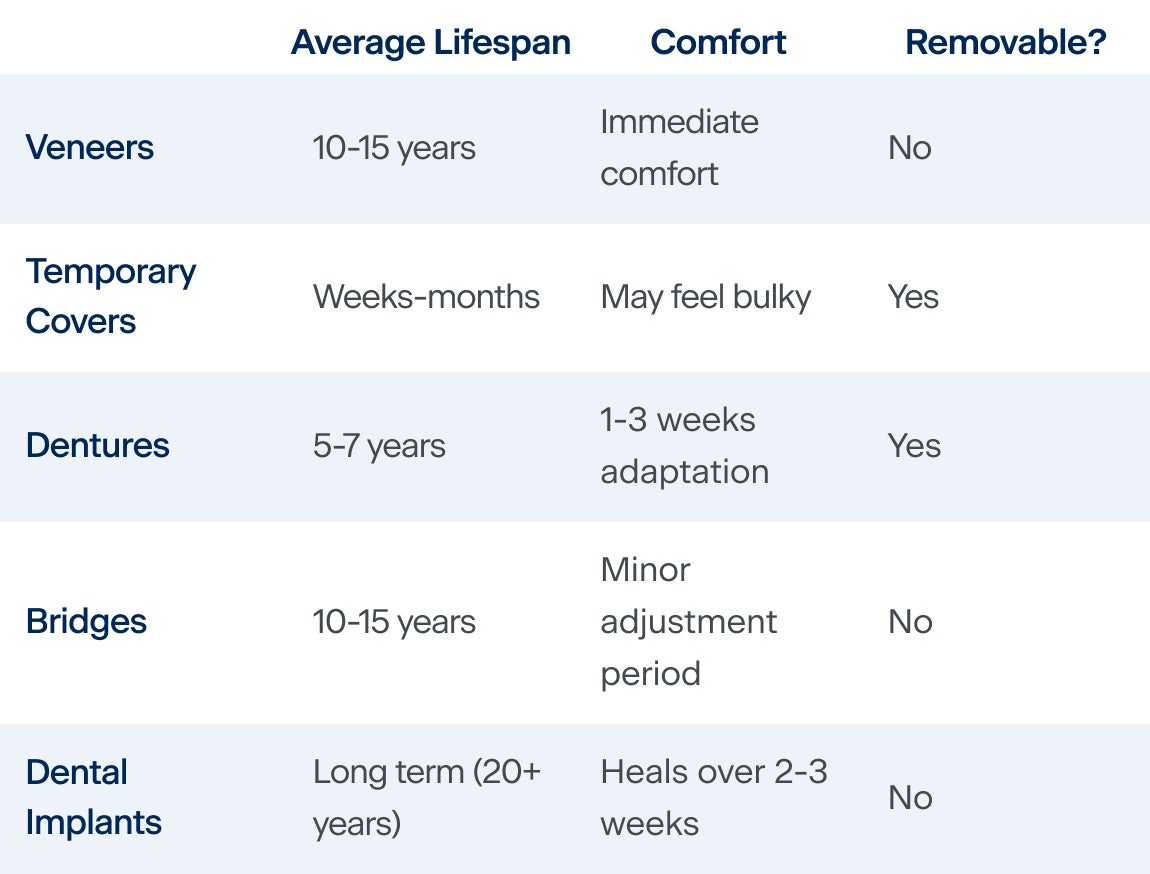Last updated 11.18.2025
Fake teeth options compared: Aesthetics, function & cost
Detailed guide comparing false teeth by type, look, lifespan, cost & how to choose what fits your needs and smile.

Learn more about Dr. Mark Andrawis

ClearChoice specializes in dental implants, but we know they’re just one of several ways to restore your smile. Explore types of false teeth, from veneers to implants, with details on appearance, materials, durability, and cost. Learn which option best fits your lifestyle and budget.
What do we mean by “fake teeth” or “false teeth”?
The term “false teeth” (or “fake teeth”) can describe any artificial dental restoration that replaces or improves natural teeth. These are more slang terms for tooth replacements. Dentists call them prostheses, and rightfully so, there is an incredible amount of science and sophistication required to create these teeth and goes way beyond putting a filling in a cavity. Prostheses can include everything from cosmetic veneers to full dental implant restorations.
People seek prosthetic teeth for several reasons:
Replacing missing teeth lost to decay, trauma, or gum disease
Repairing damaged or worn teeth
Improving smile aesthetics and confidence
Restoring chewing comfort
Each solution differs in function, appearance, and longevity, and understanding these differences helps you make the best decision for your health and lifestyle.
Aesthetic prosthetic teeth: For looks rather than needing to fix full function
Veneers
Veneers are thin shells that attach to the front surface of existing teeth. They improve color, shape, or alignment for people whose natural teeth are intact but cosmetically imperfect. Usually these are placed on front teeth.
Materials: Porcelain or composite resin
Lifespan: Usually 10–15 years with proper care and careful choice of foods
Limitations: They do not replace missing teeth; they enhance existing ones
Cosmetic temporary teeth
Over-the-counter “snap-on” mimic teeth for short-term aesthetics, sometimes used for events or photo shoots. They are not designed for eating or daily use, even when marketed as “false teeth covers you can eat with.”
Lifespan: Weeks to months
Function: Cosmetic only, little to no bite strength
Caution: Long-term use can trap bacteria, irritate gums, and promote tooth decay
Functional and aesthetic prosthetic teeth: Full or partial restoration of chewing, speaking, and comfort
Dentures (full, partial, or flexible)
Dentures are removable prosthetics that replace some or all missing teeth.
Full dentures rest on the gums and replace an set of teeth.
Partial dentures clip around remaining teeth and supports the prosthetic teeth filling the gaps.
Flexible dentures sometimes called “flexi” use softer polymers that allow the prosthesis to flex around the natural teeth to go into place and to reduce breakage risk.
Pros: Non-invasive, relatively affordable
Cons: May shift during eating or speaking; can accelerate bone loss over time, flexible ones bend during eating so they may not be very functional
Lifespan: 5–7 years on average
Fixed bridges
A bridge replaces one or more missing teeth by anchoring to adjacent teeth or implants.
Types include:
Traditional dental bridges: Crowns on neighboring teeth support one or more artificial teeth.
Cantilever bridges: Anchored on only one tooth or implant to replace more than one tooth. Rarely used unless the two teeth are small, and it should not be used for chewing.
Maryland bridges: Use a metal or ceramic framework bonded behind adjacent teeth. First used at the University of Maryland.
Pros: Fixed in place, natural look
Cons: May stress supporting teeth, do not stop bone loss under the missing tooth area
Lifespan: Around 10–15 years
Dental implants
Dental implants and the prosthesis attached replaces the entire tooth structure—from root to crown. A titanium post integrates with the jawbone and supports a custom prosthetic tooth or bridge.
Common configurations include:
Implant-supported dentures (removable). Also called an implant overdentures
All-on-4® / All-on-6 restorations for full-arch replacement
Pros: Stable, natural-looking, help maintain jawbone structure
Cons: Require adequate bone and surgical placement
Lifespan: Designed for long-term function when cared for properly
Material choices and what they mean for look, durability, and cost

Lifespan and adaptation

Daily care differences
Removable options (dentures, flexible dentures): Clean with mild soap and water, soak overnight. Avoid hard chemicals, boiling water or bleach.
Fixed options (veneers, bridges, implants): Brush twice daily, floss or use water flossers, and maintain professional cleanings.
Replace or adjust as needed if fit changes or damage occurs.
Getting teeth with ClearChoice
At ClearChoice Dental Implant Centers, you’ll meet a full team; including prosthodontists, oral surgeons, and on-site lab technicians, who collaborate under one roof. This integrated model allows the team to evaluate which dental implant restoration best fits your anatomy, lifestyle, and long-term goals.
ClearChoice focuses exclusively on dental implants, which offer a much longer functional lifetime then prostheses like veneers or bridges, so every treatment is designed for lasting transformation. Modern 3D imaging, digital smile design, and guided surgical technology help ensure precision and efficiency. Whether you need a single-tooth replacement or a full-arch restoration, your ClearChoice team will create a personalized plan built around implant solutions.
Cost, insurance, and financing
ClearChoice Dental Implant Centers do not process or accept insurance directly. Patients receive an itemized bill that they may submit to their insurer for potential reimbursement; coverage depends on individual plans.
Financing and affordability
Centers offer access to third-party financing options that may help make treatment costs more manageable. Transparent, all-inclusive pricing lets patients know the cost of care upfront, without hidden fees.
Discover your best tooth-replacement option
If you’re exploring ways to replace missing or damaged teeth, schedule a free consultation at your nearest ClearChoice Dental Implant Center. Meet your full care team under one roof and learn how modern materials, digital planning, and personalized design may help you regain function, aesthetics, and confidence.
Fake teeth option FAQs
What type of false teeth look most natural?
Implant-supported restorations and high-quality dental bridges and veneers generally offer the most natural appearance because they are customized in shape, shade, and translucency.
How long do false teeth usually last?
Generally removable prosthetics like dentures last 5 years before relining or replacement isneeded. Veneers may last 10-15 years if designed and placed correctly.
Can anterior veneers replace missing teeth or are they only cosmetic?
Veneers are cosmetic enhancements that attach to existing teeth. They do not replace missing teeth or support chewing function.
Are implant-supported dentures worth the extra cost?
Many patients find implant-supported dentures (implant overdentures) more comfortable and stable than regular dentures because they attach to implants rather than only resting on the gums. This stability may help preserve bone and improve confidence while eating or speaking.
How do I decide whether dentures, bridges, or implants are right for me?
Your prosthodontist will evaluate bone health, number of missing teeth, and overall goals. For short-term affordability, dentures may suffice; for durability and bone preservation, implants often provide the most comprehensive outcome.



